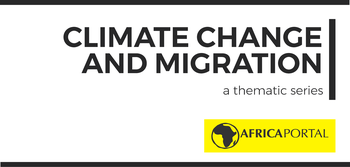
Dr Katharine Vincent, Director of Kulima Integrated Development Solutions, a climate change adaptation and disaster risk reduction consultancy, provides insight into climate change-induced migration in Southern Africa and the need for legal protection of migrants. This is part of our series on Climate Change and Migration in Africa.
Southern Africa has long been characterised by migration and climate change is one of many factors that will influence migration patterns in a variety of ways. But as a policy issue, addressing migration has always been thorny. SADC lags behind other regions in Africa in finalising protocols, policies and agreements for safe and formal migration. With migration likely to continue, and potentially change in nature due to climate change, having frameworks in place is essential to capitalise on the opportunities it presents. If not, the reality is that migrants’ rights will continue to be overlooked and the system will perpetuate inequalities.
Migration has a long history in southern Africa
Migration – whether within a country or across international boundaries – has a long history in southern Africa. According to the International Organisation for Migration (IOM), over 4 million documented migrants were recorded in the region in 2013. South Africa accounts for the lion’s share, both in terms of receiving and sending migrants, but every SADC member state receives migrants.

Rural-urban labour migration, where largely semi-skilled and unskilled people move in search of income-earning opportunities, has typically been popular. Whilst South Africa has historically attracted migrants, for example to work on the mines, rapid industrialisation in Botswana and Zambia means that they are also now common destinations. There are also a significant number of refugees and displaced persons in the region – defined as people who have been forced to leave their homes for fear of persecution or due to disasters, such as flooding and tropical cyclones.
What about climate migrants and climate refugees?
Many alarmingly large numbers have been bandied about with regard to the potential number of climate refugees or climate migrants. A recent UN report anticipated that between 25 million and 1 billion people might be climate migrants by 2050. Earlier this year, a landmark ruling by the United Nations Human Rights Committee officially recognised climate refugees for the first time, adding weight to the concept, after determining that New Zealand was wrong to deport a family from Kiribati who had applied for asylum due to rising sea levels.
But the reality is much more complex. How will climate change affect migration patterns in southern Africa?
“Over the past four decades (1980-2016) weather-related disasters in the SADC region left 2.47 million people homeless”.
It is clear that rapid onset hazards, such as tropical cyclones and floods, will continue to cause displacement. Over the past four decades (1980-2016) weather-related disasters in the SADC region left 2.47 million people homeless. A year after tropical cyclone Idai, 100,000 people are still living in resettlement sites in Mozambique.
The magnitude of such extreme weather events is expected to rise as temperatures increase. As well as tropical cyclones and floods, slow-onset disasters such as drought (often associated with El Niño) are already a major challenge in southern Africa. Temperature increase in southern Africa is likely to exceed the global average, particular in the interior, and we can expect to see more frequent very hot days. The rainfall variability that characterises the region is likely to become more extreme (for more information, see Climate Risk and Vulnerability: A handbook for southern Africa).
The impact on migration of incremental climate change and the changes in temperature and rainfall is much less clear. In contrast to the climate migrant discourse, I was recently involved in a major research project in deltas in Africa and Asia which surveyed migrant households, finding that “environment” was cited as the reason for migration by less than 1%, compared with “economic factors” which was cited by over 80%. Of course the two factors are not independent: the inability to earn a decent living from farming in an environment that is becoming progressively hotter and with more erratic rainfall may indeed mean that someone chooses to migrate for economic reasons – but environmental factors, including the climate, may underpin that reality.
To migrate or not migrate?
Even if climate risk is increasing, the decision to migrate is rarely an easy one. The importance of home and what migration scholars call “place attachment” means that many people are often willing to remain in imperfect environments, despite the effects on their lives and livelihoods. This is also shown in cases of resettlement from risky areas, where many of the people resettled to new, safer locations end up returning to their original homes.
One school of thought views the decision to migrate as reflecting the balance between aspirations (i.e. the desire to move) and capabilities (i.e. the ability to move). Climate risk is one of many factors that contributes to the context in which migration decisions are taken. Much more research is needed to unpack how climate change will affect aspirations and capacities, and thus how it will affect migration patterns – in terms of who migrates, where they migrate, and with what effect.
Who are the winners and losers?
Arguably the biggest concern for climate change and migration is for those who have to involuntarily move – not because they want to, but because their life becomes untenable where they are. Studies show the climate stresses and shocks rarely change the aspirations of rural populations to leave their homes – except for younger people from better-off households. The tragedy is that those people with the lowest capabilities are more likely to be forced to migrate for survival compared with those with higher capabilities.
“Migration has positive effects on the economy – with 2 jobs in South Africa generated for every migrant.”
People who move involuntarily – because they are out of other options to stay where they are – often continue to live precarious lives. Due to their lower capabilities, they may find themselves living in exposed locations, or eking out a hand-to-mouth existence in the informal economy which, itself, is vulnerable to climate change and other stresses.
When crossing international boundaries, such migrants may do so illegally, further meaning that they have no access to social protection or legal rights in their new home.
Despite its long history of migration, the perceptions of migrants in southern Africa is largely negative. Many migrants that move to other countries are subject to discrimination and exploitation. In South Africa in particular, xenophobia and violence towards migrants is all too frequent. This is despite the fact that evidence shows migration has positive effects on the economy – with 2 jobs in South Africa generated for every migrant.
The need to have policy frameworks to manage migration
Negative public perceptions of migration are reflected in political fora, where discussions on regional management of migration have been slow. Whilst other regional economic communities, such as the Economic Commission of West African States (ECOWAS) and the East African Community (EAC) have made progress towards free movement for citizens, SADC’s Draft Protocol on the Facilitation of Movement of Persons has been ratified by only a handful of countries, far short of the two thirds of member states required for it to come into force. This contributes to the situation where migration is not embraced and the rights of migrants are not protected.
The SADC Treaty requires SADC to develop policies to eliminate obstacles to free movement of people (as well as goods, services and capital). At the continental level there are two major agreements relating to migration. The African Union’s Migration Policy Framework emphasises that well-managed migration has significant benefits – both to the countries of migrants’ origins and their destinations. The African Common Position on Migration and Development calls on member states to harmonise their legislation with international conventions, protect the rights of migrants and enact policies on preventing discrimination, racism and xenophobia.
Planning for migration maximises benefits for all
Migration in southern Africa is a reality for the long-term. Climate change is one of many factors that influences migration patterns and the precise way in which this will unfold needs further investigation. However the risk is that climate change will increase involuntary migration which, when international borders are crossed, may be illegal.
The potential benefits of migration are well documented – both to migrants themselves, and to both the countries they move to and the ones they move from. But these benefits are less likely to accrue when appropriate policy frameworks are not in place, leaving migrants vulnerable and excluded. Embracing migration and actively planning for it is thus essential to shift the pendulum and ensure it generates opportunities and benefits.
(Main image: A human smuggler cuts a border fence while illegally bringing Zimbabwaen refugees across the border into South Africa, 27 May 2008 near Musina, South Africa – John Moore/Getty Images)
The opinions expressed in this article are those of the author(s) and do not necessarily reflect the views of SAIIA or CIGI.
Enjoyed this? Then check out the rest of the Climate Change and Migration in Africa series here.


